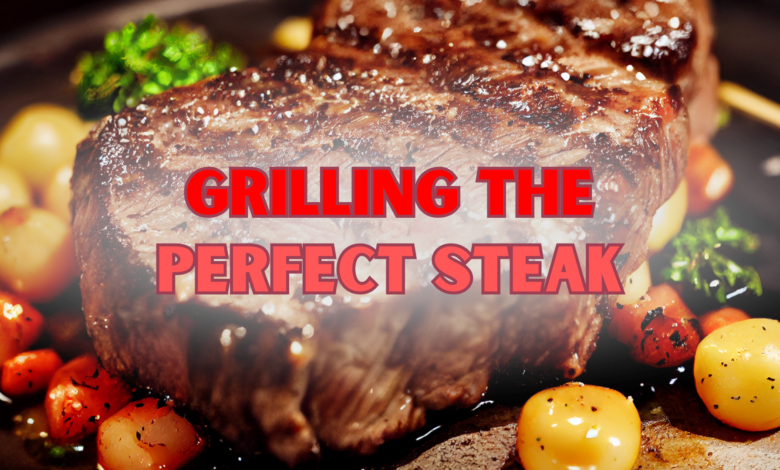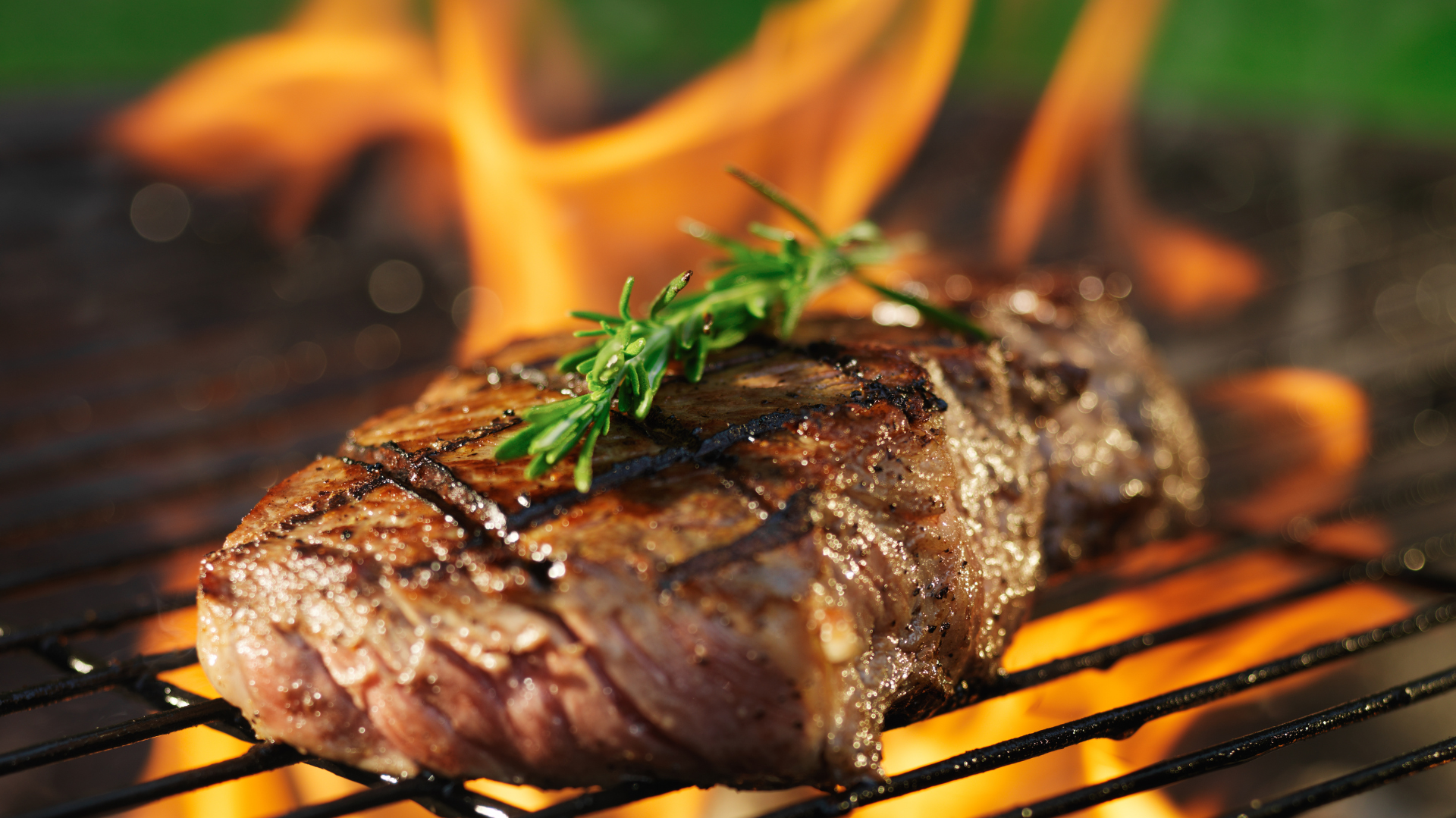Grilling the Perfect Steak: A Mouthwatering Story, Expert Tips, and Stats to Impress

What is Grilling the Perfect Steak?
Grilling the perfect steak is a method of cooking a cut of beef on an open flame or grill until it has reached your desired level of doneness. It requires knowledge and attention to detail to ensure the best possible results.
- The type of steak, its thickness, and marbling all affect grilling time
- Proper seasoning with salt, pepper, and any desired herbs/spices enhances flavor,
- Allowing steaks to rest for several minutes before serving allows juices to redistribute throughout the meat
Step-by-Step Guide: How to Grill the Perfect Steak Every Time
Grilling the perfect steak can be an art form, and it’s one that many people strive to master. It doesn’t matter if you’re a seasoned pro or a beginner; everyone can learn how to grill the perfect steak every time by following these simple steps:
1. Choose your cut of meat
The first step is choosing the right cut of meat. While there are many different cuts available, some of the best for grilling include ribeye, T-bone, and sirloin. Look for well-marbled steaks with even thickness.
2. Preheat your grill
Preheating your grill is crucial to getting a good sear on your steak. Turn all burners on high and let them heat up for about 10-15 minutes until they reach around 500°F.
3. Season your steak
Seasoning plays an important role in bringing out the natural flavors of your steak while also enhancing its texture and juiciness. For most cuts of beef, keep it simple with just salt and pepper rubbed onto each side.
4. Grill over direct heat
Cooking over direct heat produces a delicious charred crust while maintaining a juicy, soft interior without having to worry too much about precision cooking times per side.
For medium-rare, About 6 minutes per side will do
For rare: Around four minutes, medium-well to well-done takes need close attention from constant temperature checkup
5. Let rest
Once done, skip cutting into it, as satisfying as this may feel. Allow enough time, like a five-minute clock, before slicing smaller pieces diagonally across the grain, letting juices have ample opportunity to redistribute throughout after wilting inwardly towards the center during the charring process.
Now that you know how to properly grill a perfectly juicy steak, take care not to remind yourself to move forward better than at any restaurant – go forth!
FAQs About Grilling the Perfect Steak: Common Mistakes, Myths, and Misconceptions
Grilling the perfect steak is an art that many people aspire to master. There’s nothing quite like biting into a juicy, perfectly cooked piece of meat straight off the grill. However, there are some common mistakes and misconceptions that can turn even the best cuts of beef into tough, overcooked disappointments. In this post, we’ll explore some frequently asked questions about grilling steak and dispel some common myths.
Question #1: Should I sear my steak first or cook it low and slow?
This question has been hotly debated among grill masters for years. Some swear by high heat to create a crispy crust on their steaks before cooking them at lower temperatures to finish them off. Others prefer the reverse sear method–cooking the steak slowly over low heat until it reaches its desired internal temperature before finishing it with a quick sear at high heat.
In the end, the response is determined by your personal preferences for texture and mouthfeel. If you enjoy a crunchy exterior with a tender interior, then go ahead with searing. But if you crave those delicious juices within every bite, then slow-cooking might be your choice.
Question #2: How should I season my steak?
Seasoning is crucial in creating an outstanding grilled steak experience! Salt plays an important role here as it enhances not only flavor but also encourages much-needed moisture retention while placed under high temperatures.
For extra depth of flavor, add garlic powder, onion powder, or any dry seasoning blend that suits your taste buds perfectly fine- remember, just don’t overwhelm it.!
Pro-tip:
Before adding spices, run through visual cues (color change). When salt is sufficiently added – carefully rub oil onto both surfaces prior to barbecuing. This way, salt will stick better, giving out all flavors from the barbecue and making each bite unforgettable!
Question #3: Does marinating my steak make any difference?
Marinades may look fancy, but they do not always guarantee success on the grill. It is important to remember that marinades mostly sit on, flavoring and tenderizing only up to a shallow depth of meat.
Although adding an acidic component can definitely help with softening, extenuating flavor profiles, and infusing general moistness levels – be sure not to let your steak reside in it for extended periods as acid whittles away at iron molecules, which affects texture, making it mushy! Usually, 30 minutes or so will deliver subtle yet effective results (‘tender,’ ‘juicy’).
Question #4: How do I know when my steak is done?
Knowing exactly when your steak has reached its optimal temperature can turn a good meal into an excellent one – Let’s get started.
The main elements are cook time, heat intensity, and thickness of cut; however, there is no definitive answer to this question. Here we provide possible clues- if you enjoy rarely, then aim for an internal temp around 130°F (54°C); medium-rare runs between 135°f-140°F(57°c-60°c), whereas medium falls within 145°F-155°F(63°C -68°C). As far as full cooking goes, anything beyond these would heavily depend upon personal preferences because they go from the pinkish-red middle towards a brown-grey area all the way through till a charred surface appears (imparted taste ).
Pro-tip:
Temperature check is best achieved via instant-read thermometer, although once you’ve mastered different cooking styles, just trust yourself by using the poke-test method by checking the resistance of meat before slicing it open and finally letting each piece rest under foil for about five minutes, optimizes juice delivery, retaining optimal juiciness throughout.
Question #5: Can I reuse leftover marinade?
Reusing leftover marinate sounds like a great idea, but given how unsafe handling conditions may result in leaving ingoing germs, alterations to the original ingredients don’t risk health issues! Make a fresh batch whenever you plan on marinating your steaks.
Grilling the perfect steak requires some careful consideration and attention to detail. By avoiding common mistakes and misconceptions, like overcooking or using old marinade, we can all achieve mouthwatering results that make every bite worth savoring! Best of luck with your next barbecue frenzy – Have fun!
Top 5 Facts You Need to Know Before Grilling the Perfect Steak
As springtime arrives and the temperature rises, there is nothing better than firing up the grill for a perfectly cooked steak. However, achieving that perfect grilled steak can be a daunting task if you don’t know what you’re doing. To help make your next grilling experience a success, we’ve compiled five key facts you need to know before grilling the perfect steak.
1) Start with quality meat
The cornerstone of any great meal starts with high-quality ingredients. This includes choosing premium cuts of beef from reputable sources like grass-fed or grain-finished varieties. Look for marbled steaks, as they tend to have more flavor and are less likely to dry out during cooking.
2) Seasoning is Key
Steak seasoning goes beyond just sprinkling some salt on top; it’s about enhancing the natural flavor of beef while balancing out any acidic or sweet notes in sauces or rubs. Make sure to season both sides generously using freshly ground black pepper and kosher salt prior to placing it onto the grill.
3) Let Your Steak Warm Up Before Grilling
One common mistake many people make when grilling their steak is taking them directly from the refrigerator to cook over high heat. It’s important not only to remove your steaks from refrigeration at least an hour before cooking but also to allow them 30-45 minutes on the counter so they can reach room temperature right before hitting the grill.
4) Pay Attention To The Temp & Timing
Knowing how long and at what temperatures to cook your steak depends on its thickness and desired level of doneness – whether rare, medium-rare, medium, medium-well done, or well-done; each stage requires varying internal temperatures, which could range between 120F up to 160F.
In general rule of thumb is: For rare, aim around (125°F); Med-Rare (135°F); Medium (145°F); Med-Well Done -155°F; Well done(160°F). That means that you may want to invest in a meat thermometer so you can take the temperature of your steak to see whether it’s cooked perfectly without too much guessing.
5) Resting Your Steak Is Critical
One common mistake that many people make when grilling their steak is carving it right away after removing it from the grill. This causes them to lose all their juices, leading to a dry or chewy texture— rather than the juicy tenderness you look for in grilled steaks.
Letting your steak rest before cutting allows the juices and flavors inside the steak time to redistribute evenly, giving perfect flavor with every bite. So cover the freshly grilled and tented steaks with aluminum foil for at least five minutes while letting their taste reach its full potential.
Anyone can become an expert grill master by applying these tips along with proper technique and practice – You’re on your way towards mouthwatering perfection that grabs the attention of food enthusiasts around the board!
Choosing the Right Cut of Meat for Grilling: A Beginner’s Guide
Grilling is one of the most popular and dynamic methods for cooking meat. It’s a favorite activity in many households, especially during summertime when everyone wants to be outside soaking up some sun while enjoying good food. If you’re new to grilling, then it would be best if you start with choosing the right cut of meat. Although that can seem overwhelming initially, once you understand the different kinds of cuts and what they offer, it’ll be much easier to decide which type will suit your preferences.
When selecting beef or any other kind of meat for grilling, there are three critical factors you need to consider: flavor profile, texture/tenderness, and fat content/marbling. Understanding how these variables affect the final product will help improve your cooking experience as well as its outcome.
Flavor Profile: Every piece of meat has its unique taste profile depending on where it comes from on an animal’s body. The muscle directly over hot spots like ribs or loins tends to have more Marbling than cuts from elsewhere due to their close proximity with bones, which protect them from overheating during cooking at high temperatures.
Texture/Tenderness: Some pieces of meat are tougher/chewier than others before being cooked. These cuts require time-consuming marinades – specifically designed so flavors penetrate deep within fibers- hence making them tender, such as flank steaks or short ribs.
Fat Content/Marbling: Fat provides moisture; this means juiciness is delivered after resting ~5 minutes between removing the heat source & cutting meats, thus ensuring optimum tenderness sought-after in pork chops, etc. But not all fats are equal. A term often used called Marbling (or intramuscular fat) looks impressive yet tender compared to the per-fat layer covering surfaces around certain areas known as subcutaneous adipose tissue, giving rise to briskets frequently seen via strong BBQ cultures.
It’s essential to always consider specific types based on eating requirements/situations, too! For instance, if preparing for a large crowd of guests with different preferences and dietary restrictions -you might opt to cook both chicken & steak over grilled vegetables, thus offering something for everyone.
Now, it’s time to familiarize yourself with various cuts. Here are some popular grilling meat options:
1. Ribeye: This cut comes from the beefy midsection area, known as the rib primal, making this choice among chefs who always serve finger-licking steaks at top-end restaurants. Due to its natural intramuscular fat marbling within fleshy muscles, tenderness appeals from mouthwatering aromas created by the searingly high heat required during cooking on stabilized grill tops.
2. Tenderloin Filet Mignon: This tender cut is sourced in-between cow’s ribs/vertically located below back spines around hips, generally smaller weighing variations up to 8 ounces lowed across upscale dining establishments prepared using precision equipment achieving your desired doneness, thereby creating an explosion of flavors found nowhere else.
3. Sirloin Steak: This more affordable cut of beef encompasses larger muscle groups than previously mentioned and is relatively priced similarly but less-frequent extra consumption, suitable for serving medium-well/well-done dishes when looking for a cheaper yet equally satisfying option.
4. Brisket/Corned Beef/Renowned Pastrami favorites all stem from the same flat-cut peck significant flab, which makes them ideal choices for low and slow smoking techniques after applying generous rubs adding taste and infusing delicate smoky flavor profiles right until taken off fire.
5. Chicken Breasts/Thighs can be fantastically versatile, not only providing tremendous health benefits served plain/boneless or additive spice mixtures/marinades, turning dull poultry into juicy centerpieces decorating picnics/barbecues filled plates, delivering the quintessential sign summer has (finally) arrived!
Remember that choosing the right meats takes more than selecting based solely on color/tenderization. Techniques vary across styles, regions & cultures; hence, prioritizing the primary elements mentioned (flavor profile/texture/tenderness and fat content/marbling) will reap rewards for beginner grill enthusiasts looking to step up their culinary prowess. So be sure always to weigh your options carefully when choosing cuts as you embark on your grilling journey. Happy Grilling!
The Best Marinades and Seasonings for Grilling the Perfect Steak
Grilling a juicy and succulent steak is no simple feat. It requires patience, precision, and, most importantly, the right marinade or seasoning to elevate the flavors of your meat to new heights. Whether you’re grilling for your family or showcasing your culinary expertise at a backyard barbecue with friends, selecting the best marinades and seasonings can be crucial in producing that ideal steak everyone craves.
Not only do they enhance flavor, but marinades also tenderize tougher cuts of meats, such as flank or skirt steaks, by breaking down their connective tissues, leading to more tenderness throughout each bite. So, without further ado, let’s get into exploring some of the best marinades and seasonings for grilling a mouthwatering beefsteak that’ll have everyone asking for seconds!
1) Steakhouse-Style Marinade: This classic blend features ingredients like Worcestershire sauce, soy sauce, garlic powder, onion powder, and red wine vinegar, bringing deep umami flavors that are rich yet well-rounded enough not to overshadow the meat’s inherent flavor.
2) Beer-Based Marinade: What better way to introduce unique aromas than with a cold bottle of beer? Dark beers like stout bring bold roasted tastes, while lighter wheat beers leave behind sweetness, making them ideal for suiting any individual’s liking.
3) Garlic Herb Seasoning Blend: A skewer full of perfectly grilled vegetables laid out on top alongside this garlic herb seasoned steak will certainly catch everybody’s attention at cookouts; despite being vegetarian-friendly, an aromatic mixture consisting mainly of dried thyme & rosemary gives freshly vibrant afternoon delight savors coupled together giving really interesting flavors working hand-in-hand which balances nicely with sometimes hearty vegetables in particular root veggies.
4) Coffee Infused Rubs: An unexpectedly good match culling masterfully caramelized coffee notes through smoked paprika pieces as part chili powders, adding zest from spices makes sense after years’ worth of experimentation stemming straight from the heart of barbecue kings.
5) Spicy Chimichurri Sauce: So simple yet so tangy herb sauce comes packed with garlic, jalapenos, and red pepper flakes; a well-rounded onion presence evokes the bold spirit of traditional Argentine steak grilling that combines into just the right blend for those brave enough to try anything spicy.
There are countless marinades and seasoning combinations available on this earth. Therefore, if you’re looking to upgrade your grilled meat skills or experimenting with something new, we recommend trying a few of our suggestions above, which will make an excellent flavor pairing to any cuts like T-Bone or Ribeye Steak, bringing out their best qualities given time after it’s marinated properly for long enough. In the end, when your mates and family members let out happy sighs, then all the efforts put towards perfecting flavors will feel truly worth it!

Tools of The Trade: Must-Have Equipment for Grilling The Perfect Steak
As a grilling enthusiast, you know that the right equipment can make all the difference between an average cookout and a mouthwatering spread of succulent meats. The perfect steak takes precision, patience, and, most importantly, the proper setup. If you want to achieve perfectly grilled steaks every time, here are some tools of the trade that you must have in your arsenal.
The Grill
Of course, your grill is going to be the backbone of your entire operation. There are endless types of grills out there on the market today- from gas and electric models to charcoal or pellet smokers.
Each type has its individual merits; however, for producing juicy steaks with exceptional flavor development – nothing beats a traditional charcoal grill. Charcoal imparts an unmistakable smoky taste to every cut of meat while providing unparalleled heat distribution.
Additionally – if choosing gas as one prefers-, always invest in a high-quality brand such as Weber Genesis II E-335, which not only delivers outstanding temperature accuracy but produces reliable results time after time!
An Instant Read Thermometer
Being able to accurately gauge internal temperatures is key when it comes to eating safe food.
However, checking the doneness level could become confusing at times, especially
when grilling two or more cuts together by eyesight alone–not exactly practical nor precise. You need an instant-read thermometer like Thermapen Mk4
which reads within seconds and displays accurate reading within tenths-of-a-degree F., ensuring complete confidence in what’s being served at any given moment! You will never again risk serving overcooked beef chunks!
Chimney Starter
I can’t stress enough the importance of evenly heated coals throughout the cooking process.
Fortunately, a chimney starter greatly assists even heating through consistent fire production during preparation!
Stack natural lump hardwood briquets (click here) securely inside the chimney — fill the bottom cavity with paper starting-point wadded up in order to fire up fuel via just lighted newspaper below,
Result: complete, even, fully matured charcoal ready when it’s time to spread for cooking!
Grilling Baskets
Make life easier and more uniform by using grilling baskets
These nifty tools enable you to cook specific cuts with precision.
Ensuring optimization on perfect-textured meal instance after instance.
Spatula
We’re not talking about cheap dollar-store flippers here. Invest in wide turners made from high-quality stainless steel with long handles like OXO Good Grips.
(not just overall great brand name but optically appealing too!)
Grips offer handling comfort during their presumably long lifetime of usage – vital for avoiding any potentially deadly fireplace incidents!
BBQ Gloves
The question of these might have crossed your mind once in a while: why do we need gloves when there are already our trusty spatulas… Here’s the thing: Wearing BBQ heat-resistant gloves means ultimate safety -both parents or head chef and guests alike will be assured that everyone is far removed from possible burns or accidents while preparing their meals.
Equipping yourself with proper equipment helps greatly in guaranteeing perfectly grilled steaks that rise above the common level each time! Sure, buying one item at a time could be ideal cost-wise, but do invest gradually as all items presented tend to serve imperative roles, respectively, making the whole grilling experience pleasurable and legitimate. Your taste buds are definitely worth it!!!
Table with Useful Data: Grilling the Perfect Steak
| STEAK THICKNESS | COOK TIME (PER SIDE) | INTERNAL TEMPERATURE | FLAVOR PROFILE |
|---|---|---|---|
| 1 inch | 4-5 minutes | 145°F (medium rare) | Juicy with a slightly pink center |
| 1.5 inches | 6-7 minutes | 145°F (medium rare) | Developed crust with a juicy, pink center |
| 2 inches | 8-10 minutes | 145°F (medium rare) | Crisp crust with pink center and juicy interior |
| 2.5 inches | 12-14 minutes | 145°F (medium rare) | Carmelized crust with a tender, pink interior |
Information from an expert
Regarding grilling the ideal steak, preparation is key. Start by selecting a quality cut of meat and, before adding it, season it with salt, pepper, or any other flavor. Allow the steak to come to room temperature before cooking, then sear over high heat on each side for a few minutes until a crust forms. Transfer the steak to an indirect heat source and proceed to cook until the desired doneness is reached. Finally, let the steak rest for five minutes before slicing to ensure juiciness. Remember, practice makes perfect – keep experimenting until you find your own method for achieving grilled steak perfection!
Historical fact:
The ancient Greeks and Romans used a method of grilling meat called “spits,” where the meat was skewered on a long stick and slowly rotated over an open flame until perfectly cooked



